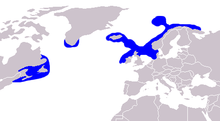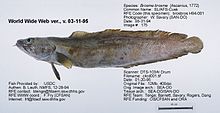Cusk (fish): Difference between revisions
MasterDirk (talk | contribs) m try again |
GrahamBould (talk | contribs) mNo edit summary |
||
| Line 45: | Line 45: | ||
==External links== |
==External links== |
||
*[http://www.state.me.us/dmr/recreational/fishes/cusk.htm More information on Cusk] |
* [http://www.state.me.us/dmr/recreational/fishes/cusk.htm More information on Cusk] |
||
[[Category: |
[[Category:Lotidae]] |
||
[[Category:Fauna of Scotland]] |
[[Category:Fauna of Scotland]] |
||
Revision as of 13:56, 10 November 2006
| Cusk | |
|---|---|

| |
| Scientific classification | |
| Kingdom: | |
| Phylum: | |
| Class: | |
| Order: | |
| Family: | |
| Genus: | Brosme |
| Species: | B. brosme
|
| Binomial name | |
| Brosme brosme (Ascanius, 1772)
| |
The cusk or tusk, Brosme brosme, is a marine cod-like fish in the ling family Lotidae. It is the only species in the genus Brosme.[1] Other common names include brismak, brosmius, torsk and moonfish.[2]
Description
It is easily distinguished at a glance from other cod-like fish as it has only one dorsal fin. Also characteristic is the nature of the dorsal, caudal, and anal fins, they being continuous at the base but separated by very deep notches so theat they are obviously distinct. Moreover, the caudal fin is evenly rounded. It is variable in color, from slate to reddish brown above, and paling to gray on the lower sides and underneath. Older fish are usually plain colored, while the young often have transverse yellow bands on the sides. The maximum length is about 3 feet (100 cm) and top weight about 30 pounds (14 kg).
Distribution and habitat

It is distributed on both sides of the North Atlantic, mostly in moderately deep water. On the North American coast it is regularly found southward to Cape Cod and occasionally off New Jersey. Its maximum range covers most of the North Atlantic, including the waters around Iceland and the Norwegian coast.[1]
It is normally found in water deeper than sixty feet (20 m), and practically always is taken over rough bottoms where rocks, ledges, or gravel are common. Good fishing areas are usually much more limited than is the case with cod, haddock, or pollock. It is an offshore fish and rarely is one taken in a harbor.
Habits
It spawns in the spring and summer, usually between April and early July. A medium sized female has been known to produce more than two million buoyant eggs. The young live near the surface until they are about 2 inches (5 cm) long, and then seek out rocky ocean floors in deep water.
Food
It is strictly a bottom-dwelling species, and is sluggish and a rather weak swimmer. It eats crustaceans and other soft bodied invertebrates and mollusks.
Fishing technique

Cusk are primarily fished on the North American North Atlantic coastal shelf near the American state of Maine and the Canadian Maritimes.
In the Gulf of Maine, cusk are chiefly taken on hook and line. Line trawls account for most of the commercial catch off the New England coast, and most of them are caught during the winter and spring. The commercial catch individuals run between 1 and 2 feet long (30–60 cm), and average about 5 pounds (2 kg). It is an excellent food fish. It is marketed as fresh or frozen fillets; a part of the catch is smoked.
Fisheries and Oceans Canada considers this species threatened as west Atlantic catches fell by roughly 90% from the 1970s to the late 1990s.[3] The US and Canada both sharply restrict catches of cusk and although once an important food fish, it is now almost completely unavailable in North American markets.
References
- ^ a b Froese, Rainer; Pauly, Daniel (eds.) (2006). "Brosme brosme" in FishBase. May 2006 version.
- ^ Cusk - at Agriculture and Agri-Food Canada
- ^ SARA registry report on Cusk (PDF) - Fisheries and Oceans Canada report on the state of cusk fisheries
- E. C. Raney "Cusk." The Wise Fishermen's Encyclopedia (1951)
